Muskox
The muskox (Ovibos moschatus, in Latin "musky sheep-ox"), also spelled musk ox and musk-ox (in Inuktitut: ᐅᒥᖕᒪᒃ, umingmak; in Woods Cree: ᒫᖨᒨᐢ, mâthi-môs, ᒫᖨᒧᐢᑐᐢ, mâthi-mostos), is an Arctic hoofed mammal of the family Bovidae,[6] noted for its thick coat and for the strong odor emitted by males during the seasonal rut, from which its name derives. This musky odor is used to attract females during mating season. Its Inuktitut name "umingmak" translates to "the bearded one".[7] Its Woods Cree names "mâthi-môs" and "mâthi-mostos" translate to "ugly moose" and "ugly bison", respectively.[8] Muskoxen primarily live in Greenland and the Canadian Arctic of the Northwest Territories and Nunavut,[9] with introduced populations in the American state of Alaska, the Canadian territory of Yukon, the Scandinavian Peninsula, and Siberia.
| Musk ox | |
|---|---|
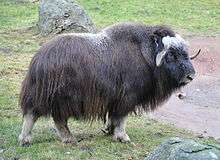 | |
| Muskox in the Lüneburg Heath wildlife park in Germany | |
| Scientific classification | |
| Kingdom: | Animalia |
| Phylum: | Chordata |
| Class: | Mammalia |
| Order: | Artiodactyla |
| Family: | Bovidae |
| Subfamily: | Caprinae |
| Genus: | Ovibos Blainville, 1816[2] |
| Species: | O. moschatus |
| Binomial name | |
| Ovibos moschatus (Zimmermann, 1780) | |
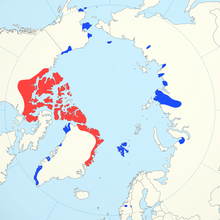 | |
| Range map: blue indicates areas where muskox introduction has been attempted in the 20th century; red indicates the previous established range. | |
| Synonyms[3] | |
|
Generic:
Specific:
| |
Evolution
Extant relatives
As a member of the subfamily Caprinae of the family Bovidae, the muskox is more closely related to sheep and goats than to oxen; it is placed in its own genus, Ovibos (Latin: "sheep-ox"). It is one of the two largest extant members of Caprinae, along with the similarly sized takin.[10] While the takin and muskox were once considered possibly closely related, the takin lacks common ovibovine features, such as the muskox's specialized horn morphology, and genetic analysis shows that their lineages actually separated early in caprine evolution. Instead, the muskox's closest living relatives appear to be the gorals of the genus Naemorhedus, nowadays common in many countries of central and east Asia. The vague similarity between takin and muskox must therefore be considered an example of convergent evolution.[11]
Fossil history and extinct relatives
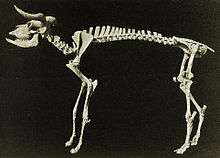
The modern muskox is the last member of a line of ovibovines that first evolved in temperate regions of Asia and adapted to a cold tundra environment late in its evolutionary history. Muskox ancestors with sheep-like high-positioned horns (horn cores being mostly over the plane of the frontal bones, rather than below them as in modern muskoxen) first left the temperate forests for the developing grasslands of Central Asia during the Pliocene, expanding into Siberia and the rest of northern Eurasia. Later migration waves of Asian ungulates that included high-horned muskoxen reached Europe and North America during the first half of the Pleistocene. The first well known muskox, the "shrub-ox" Euceratherium, crossed to North America over an early version of the Bering Land Bridge two million years ago and prospered in the American southwest and Mexico. Euceratherium was larger yet more lightly built than modern muskoxen, resembling a giant sheep with massive horns, and preferred hilly grasslands.
A genus with intermediate horns, Soergelia, inhabited Eurasia in the early Pleistocene, from Spain to Siberia, and crossed to North America during the Irvingtonian (1.8 million years to 240,000 years ago), soon after Euceratherium. Unlike Euceratherium, which survived in America until the Pleistocene-Holocene extinction event, Soergelia was a lowland dweller that disappeared fairly early, displaced by more advanced ungulates, such as the "giant muskox" Praeovibos (literally "before Ovibos"). The low-horned Praeovibos was present in Europe and the Mediterranean 1.5 million years ago, colonized Alaska and the Yukon one million years ago and disappeared half a million years ago. Praeovibos was a highly adaptable animal that appears associated with cold tundra (reindeer) and temperate woodland (red deer) faunas alike. During the Mindel glaciation 500,000 years ago, Praeovibos was present in the Kolyma river area in eastern Siberia in association with many Ice Age megafauna that would later coexist with Ovibos, in the Kolyma itself and elsewhere, including wild horses, reindeer, woolly mammoth and stag-moose. It is debated, however, if Praeovibos was directly ancestral to Ovibos, or both genera descended from a common ancestor, since the two occurred together during the middle Pleistocene. Defenders of ancestry from Praeovibos have proposed that Praeovibos evolved into Ovibos in one region during a period of isolation and expanded later, replacing the remaining populations of Praeovibos.[11]
Two more Praeovibos-like genera were named in America in the 19th century, Bootherium and Symbos, which are now identified as the male and female forms of a single, sexually dimorphic species, the "woodland muskox", Bootherium bombifrons. Bootherium inhabited open woodland areas of North America during the late Pleistocene, from Alaska to Texas and maybe even Mexico, but was most common in the Southern United States, while Ovibos replaced it in the tundra-steppe to the north, immediately south of the Laurentian ice sheet.[11][12]
Modern Ovibos appeared in Germany almost one million years ago and was common in the region through the Pleistocene. By the Mindel, muskoxen had also reached the British Isles. Both Germany and Britain were just south of the Scandinavian ice sheet and covered in tundra during cold periods, but Pleistocene muskoxen are also rarely recorded in more benign and wooded areas to the south like France and Green Spain, where they coexisted with temperate ungulates like red deer and aurochs. Likewise, the muskox is known to have survived in Britain during warm interglacial periods.[11]
Today's muskoxen are descended from others believed to have migrated from Siberia to North America between 200,000[13] and 90,000 years ago,[14] having previously occupied Alaska (at the time united to Siberia and isolated periodically from the rest of North America by the union of the Laurentide and Cordilleran Ice Sheets during colder periods) between 250,000 and 150,000 years ago. After migrating south during one of the warmer periods of the Illinoian glaciation, non-Alaskan American muskoxen would be isolated from the rest in the colder periods. The muskox was already present in its current stronghold of Banks Island 34,000 years ago, but the existence of other ice-free areas in the Canadian Arctic Archipelago at the time is disputed.[11]
Along with the bison and the pronghorn,[15] the muskox was one of a few species of Pleistocene megafauna in North America to survive the Pleistocene/Holocene extinction event and live to the present day.[16] The muskox is thought to have been able to survive the last glacial period by finding ice-free areas (refugia) away from prehistoric peoples.[14]
Fossil DNA evidence suggests that muskoxen were not only more geographically widespread during the Pleistocene, but also more genetically diverse.[17] During that time, other populations of muskoxen lived across the Arctic, from the Ural Mountains to Greenland. By contrast, the current genetic makeup of the species is more homogenous. Climate fluctuation may have affected this shift in genetic diversity: research indicates colder periods in Earth's history are correlated with more diversity, and warmer periods with more homogeneity.[16]
Physical characteristics
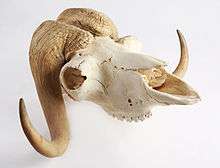
Both male and female muskoxen have long, curved horns. Muskoxen stand 1.1 to 1.5 m (4 to 5 ft) high at the shoulder, with females measuring 135 to 200 cm (4.4 to 6.6 ft) in length, and the larger males 200 to 250 cm (6.6 to 8.2 ft). The small tail, often concealed under a layer of fur, measures only 10 cm (3.9 in) long. Adults, on average, weigh 285 kg (630 lb) and range from 180 to 410 kg (400 to 900 lb).[10][18] The thick coat and large head suggests a larger animal than the muskox truly is; the bison, to which the muskox is often compared, can weigh up to twice as much.[19] However, heavy zoo-kept specimens have weighed up to 650 kg (1,400 lb).[3] Their coat, a mix of black, grey, and brown, includes long guard hairs that almost reach the ground. Rare "white muskoxen" have been spotted in the Queen Maud Gulf Bird Sanctuary.[20] Muskoxen are occasionally domesticated for wool, meat, and milk.[21][22] The wool, qiviut, is highly prized for its softness, length, and insulation value. Prices for yarn range between $40 and $80 per ounce (28 g).[23][24][25]
A muskox can reach speeds of up to 60 km/h (37 mph).[26] Their life expectancy is 12–20 years.
Range
_(prehistoric%3B_Siberia.jpg)
Prehistory
During the Pleistocene period, muskoxen were much more widespread. Fossil evidence shows that they lived across the Siberian and North American Arctic, from the Urals to Greenland.[16] The ancestors of today's muskoxen came across the Bering Land Bridge to North America between 200,000[13] and 90,000 years ago.[14] During the Wisconsinan, modern muskox thrived in the tundra south of the Laurentide Ice Sheet, in what is now the Midwest, the Appalachians and Virginia, while distant relatives Bootherium and Euceratherium lived in the forests of the Southern United States and the western shrubland, respectively.[12] Though they were always less common than other Ice Age megafauna, muskox abundance peaked during the Würm II glaciation 20,000 years ago and declined afterwards, especially during the Pleistocene/Holocene extinction event, where its range was greatly reduced and only the populations in North America survived. The last known muskox population in Europe died out in Sweden 9,000 years ago,[11] and the last one in Asia, which lived on Siberia's Taymyr Peninsula, about 2,000 years ago.[17]
After the disappearance of the Laurentide Ice Sheet, the muskox gradually moved north across the Canadian Arctic Archipelago, arriving in Greenland from Ellesmere Island at about 350 AD, during the late Holocene. Their arrival in northwestern Greenland probably occurred within a few hundred years of the arrival of the Dorset and Thule cultures in the present-day Qaanaaq area. Human predation around Qaanaaq may have restricted muskoxen from moving down the west coast, and instead kept them confined to the northeastern fringes of the island.[27]
Recent native range in North America
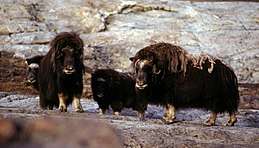
In modern times, muskoxen were restricted to the Arctic areas of Northern Canada, Greenland, and Alaska. The Alaskan population was wiped out in the late 19th or early 20th century. Their depletion has been attributed to excessive hunting, but an adverse change in climate may have contributed.[28][29] However, muskoxen have since been reintroduced to Alaska. The United States Fish and Wildlife Service introduced the muskox onto Nunivak Island in 1935 as a means for subsistence living.[30] Other reintroduced populations are in Arctic National Wildlife Refuge,[31] Bering Land Bridge National Preserve, Yukon's Ivvavik National Park, a wildlife conservation center in Anchorage,[32] Aulavik National Park in Northwest Territories, Kanuti National Wildlife Refuge, Gates of the Arctic National Park, and Whitehorse, Yukon's wildlife preserve.[33]
There have been at least two domestication endeavours. In the 1950s an American researcher and adventurer was able to capture muskox calves in Northern Canada for relocation to a property he prepared in Vermont.[34][35][36] One condition imposed by the Canadian government was he was not allowed to kill adults defending their young. When nets and ropes proved useless, he and his crew herded family groups into open water where calves were successfully separated from the adults. Once airfreighted to Montreal and trucked to Vermont, the young animals habituated to the temperate conditions. Although the calves thrived and grew to adulthood, parasite and disease resistance problems impaired the overall success of the effort. The surviving herd was eventually moved to a farm in Palmer, Alaska, which has been successful since the mid-1950s.[37]
Introductions in Eurasia
The species was introduced from Banks Island to the Dovre mountain range of Norway in 1932 but were hunted to extinction there during the Second World War. It was reintroduced to Norway in 1947; this population expanded into Härjedalen, Sweden, in 1971. It was introduced in Svalbard in 1925–26 and 1929, but this population died out in the 1970s.[38] They were also introduced in Iceland around 1930 but did not survive.[39]
In Russia, animals imported from Banks and Nunivak were released in the Taymyr Peninsula in 1974 and 1975, and some from Nunivak were released in Wrangel Island in 1975. Both locations are north of the Arctic Circle. Today the population on Wrangel Island is about 1100,[40] and that on the Taymyr Peninsula is estimated at 11-14 thousand.[41] A few muskoxen herds migrated from the Taymyr Peninsula far to the south to the Putorana Plateau.[40] Once established, these populations have been, in turn, used as sources for further introductions in Siberia between 1996 and 2010.[42] One of the last of these actions was the release of six animals within the "Pleistocene Park" project area in the Kolyma River in 2010, where a team of Russian scientists led by Sergey Zimov aims to prove that muskoxen, along with other Pleistocene megafauna that survived into the early Holocene in northern Siberia,[43] did not disappear from the region due to climate change, but because of human hunting.[44]
Introductions in eastern Canada
Ancient muskox remains have never been found in eastern Canada, despite the ecological conditions in the northern Labrador Peninsula being suitable for them. In 1967, 14 animals were captured near Eureka on Ellesmere Island by the Institute for Northern Agricultural Research (INAR), and brought to a farm in Old Fort Chimo Kuujjuaq, northern Quebec, for domestication to provide a local cottage industry based on qiviut, one of the world's finest natural fibers. Although the animals thrived and the qiviut industry showed early success with the training of Inuit knitters and marketing, it soon became clear that the Quebec government had never intended that the muskoxen be domestic, but had used INAR to capture muskoxen to provide a wild population for hunting. Government officials demanded that INAR leave Quebec and the farm be closed. Subsequently, 54 animals from the farm were released in three places in northern Quebec between 1973 and 1983, and the remaining were ceded to local zoos. Between 1983 and 1986, the released animals increased from 148 to 290, at a rate of 25% per year, and by 2003, an estimated 1400 muskoxen were in Quebec. Additionally, 112 adults and 25 calves were counted in the nearby Diana Island in 2005, having arrived there by their own means from the continent. Vagrant adults are sometimes spotted in Labrador, though no herds have been observed in the region.[45]
Ecology
During the summer, muskoxen live in wet areas, such as river valleys, moving to higher elevations in the winter to avoid deep snow. Muskoxen will eat grasses, arctic willows, woody plants, lichens, and mosses. When food is abundant, they prefer succulent and nutritious grasses in an area. Willows are the most commonly eaten plants in the winter. Muskoxen require a high threshold of fat reserves in order to conceive, which reflects their conservative breeding strategy. Winter ranges typically have shallow snow to reduce the energy costs of digging through snow to reach forage.[1] The primary predators of muskoxen are arctic wolves, which may account for up to half of all mortality for the species. Other occasional predators, likely mainly predators of calves or infirm adults, can include grizzly bears and polar bears.[3]
Social behavior and reproduction

Muskoxen live in herds of 12–24 in the winter and 8–20 in the summer.[46] They do not hold territories, but they do mark their trails with preorbital glands.[47] Male and female muskoxen both have separate age-based hierarchies, with mature oxen being dominant over juveniles.[46] Dominant oxen tend to get access to the best resources[3] and will displace subordinates from patches of grass during the winter.[46] Muskox bulls assert their dominance in many different ways. One is a "rush and butt", in which a dominant bull rushes a subordinate from the side with its horns, and will warn the subordinate so it can have a chance to get away.[48] Bulls will also roar, swing their heads, and paw the ground.[3] Dominant bulls sometimes treat subordinate bulls like cows. A dominant bull will casually kick a subordinate with its foreleg, something they do to cows during mating.[49] Dominant bulls will also mock copulate subordinates and sniff their genitals.[49] A subordinate bull can change his status by charging a dominant bull.[50]
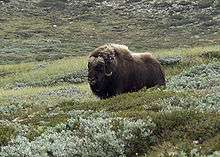
The mating (or "rutting") season of the muskoxen begins in late June or early July. During this time, dominant bulls will fight others out of the herds and establish harems of usually six or seven cows and their offspring. Fighting bulls will first rub their preorbital glands against their legs while bellowing loudly, and then display their horns.[50] The bulls then back up 20 meters, lower their heads, and charge into each other, and will keep doing so until one bull gives up.[48] Subordinate and elderly bulls will leave the herds to form bachelor groups or become solitary.[3] However, when danger is present, the outside bulls can return to the herd for protection.[51] Dominant bulls will prevent cows from leaving their harems.[3] During mating, a bull will casually kick an estrous cow with his foreleg to calm her down and make her more receptive to his advances.[49] The herds reassemble when summer ends.[51]
While the bulls are more aggressive during the rutting season and make the decisions in the groups, the females take charge during gestation.[3] Pregnant females are aggressive and decide what distance the herd travels in a day and where they will bed for the night.[52] The herds move more frequently when cows are lactating, to allow them to get enough food to nurse their offspring.[52] Cows have an eight- to nine-month gestation period, with calving occurring from April to June. Cows do not calve every year. When winters are severe, cows will not go into estrus and thus not calve the next year. When calving, cows stay in the herd for protection. Muskox are precocial, and calves are able to keep up with the herd within just a few hours after birth. The calves are welcomed into the herd and nursed for the first two months.[3] After that, a calf then begins eating vegetation and nurses only occasionally. Cows communicate with their calves through braying. The calf's bond with its mother weakens after two years.
Muskoxen have a distinctive defensive behavior: when the herd is threatened, the bulls and cows will face outward to form a stationary ring or semicircle around the calves.[53] The bulls are usually the front line for defense against predators with the cows and juveniles gathering close to them.[3] Bulls determine the defensive formation during rutting, while the cows decide the rest of the year.[51]
Components of glandular secretions
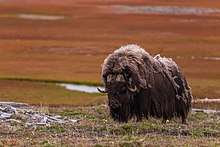
The preorbital gland secretion of muskoxen has a "light, sweetish, ethereal" odor.[7] Analysis of preorbital gland secretion extract showed the presence of cholesterol (which is nonvolatile), benzaldehyde, a series of straight-chain saturated gamma-lactones ranging from C8H14O2 to C12H22O2 (with C10H18O2 being most abundant), and probably the monounsaturated gamma lactone C12H20O2.[7] The saturated gamma-lactone series has an odor similar to that of the secretion.[7]
The odor of dominant rutting males is "strong" and "rank".[7] It derives from the preputial gland and is distributed over the fur of the abdomen via urine. Analysis of extract of washes of the prepuce revealed the presence of benzoic acid and p-cresol, along with a series of straight-chain saturated hydrocarbons from C22H46 to C32H66 (with C24H50 being most abundant).[7]
Conservation status
Historically, this species declined because of overhunting, but population recovery has taken place following enforcement of hunting regulations.[1] Management in the late 1900s was mostly conservative hunting quotas to foster recovery and recolonization from the historic declines.[1] The current world population of muskoxen is estimated at between 80,000[54] and 125,000,[30] with an estimated 47,000 living on Banks Island.[55]
In Greenland there are no major threats, although populations are often small in size and scattered, which makes them vulnerable to local fluctuations in climate. Most populations are within national parks, where they are protected from hunting.[1] Muskoxen occur in four of Greenland's protected areas, with indigenous populations in Northeast Greenland National Park, and three introduced populations in Arnangarnup Qoorua Nature Reserve, and Kangerlussuaq and Maniitsoq Caribou Reserves. Within these areas, muskoxen receive full protection.[1]
References
- Gunn, A.; Forchhammer, M. (2008). "Ovibos moschatus (errata version published in 2016)". IUCN Red List of Threatened Species. 2008: e.T29684A86066477. Retrieved 24 December 2019.
- de Blainville, M. H. (1816). "Sur plusieurs espèces d'animaux mammifères, de l'ordre des ruminans". Bulletin des Sciences Par la Société Philomathique de Paris. 1816: 76.
g. XI. Ovibos
- Lent, Peter C (1988). "Ovibos moschatus" (PDF). Mammalian Species. 302 (1–9): 1. doi:10.2307/3504280. JSTOR 3504280. Archived from the original (PDF) on 2013-05-20.
- Kowarzik, K. (1911). "Das Tränenbein von Ovibos moschatus Blainv". Zoologischer Anzeiger. 37: 106–107.
- Zimmermann, E.A.W. (1780). "Der Muskusochse". Enthält ein vollständiges Verzeichnis aller bekannten Quadrupeden. Geographische Geschichte des Menschen, und der allgemein verbreiteten vierfüssigen Thiere. 2. Leipzig: Weygandschen Buchhandlung. pp. 86–88.
- Grubb, P. (2005). "Order Artiodactyla". In Wilson, D.E.; Reeder, D.M (eds.). Mammal Species of the World: A Taxonomic and Geographic Reference (3rd ed.). Johns Hopkins University Press. p. 707. ISBN 978-0-8018-8221-0. OCLC 62265494.
- Flood, P. F.; Abrams, S. R.; Muir, G. D.; Rowell, J. E. (August 1989). "Odor of the muskox". Journal of Chemical Ecology. 15 (8): 2207–2217. doi:10.1007/bf01014110. PMID 24272381.
- Houston, Clarence Stuart; Houston, Stuart; Ball, Tim; Houston, Mary (October 2003). Eighteenth-Century Naturalists of Hudson Bay. McGill-Queen's Press - MQUP. p. 241. ISBN 9780773522855.
- Animal Life in Greenland – an introduction by the tourist board Archived 2012-04-27 at the Wayback Machine. Greenland-guide.gl. Retrieved on 2011-09-15.
- Burnie D and Wilson DE (Eds.), Animal: The Definitive Visual Guide to the World's Wildlife. DK Adult (2005), ISBN 0-7894-7764-5
- Peter C. Lent (1999). Muskoxen and Their Hunters: A History. University of Oklahoma Press. ISBN 978-0-8061-3170-2. Retrieved 2013-08-25.
- "KGS--Guidebook 5--Wisconsinan Mammalian Faunas". ku.edu.
- Wildlife Management Advisory Council (North Slope) fact sheet. taiga.net.
- "Hinterland Who's Who". Archived from the original on April 25, 2013.
- Smithsonian Institution. North American Mammals: Pronghorn Antilocapra americana
- Switek, Brian. "Prehistoric DNA Reveals the Story of a Pleistocene Survivor, the Muskox." Laelaps blog on Science Blogs, posted 10 Mar. 2010. Accessed 18 Jan. 2013.
- "Muskox Suffered Loss Of Genetic Diversity At Pleistocene/Holocene Transition". Science Daily. 2005-10-06. Retrieved 2011-03-03.
- "Ellis, E. Ovibos moschatus". Animaldiversity.ummz.umich.edu. Retrieved 2011-03-03.
- Muskox videos, photos and facts – Ovibos moschatus Archived 2012-08-25 at the Wayback Machine. ARKive. Retrieved on 2012-08-23.
- "Search for the Legendary White Musk-ox". Thelon.com. 2010-08-06. Archived from the original on 2011-07-17. Retrieved 2011-03-03.
- "Muskox Uses". Alaska Department of Fish and Game. Retrieved 2017-02-01.
- Wilkinson, Paul F. (1974). "The history of musk-ox domestication". Polar Record. 17 (106): 13–22. doi:10.1017/S0032247400031302.
- "The Qiviut Fiber and Yarn". Qiviut.com. Retrieved 2011-03-03.
- Large Animal Research Station.uaf.edu. Retrieved on 2012-08-23.
- Muskox Wool – Qiviut (Kiv-ee-oot). alaskabeadstore.com. Retrieved on 2012-08-23.
- "Muskox". moskussafari.no. Archived from the original on 2013-10-29.
- Bennike, Ole; Andreasen, Claus (2005). "New dates of musk-ox (Ovibos moschatus) remains from northwest Greenland". Polar Record. 41 (2): 125–129. doi:10.1017/S0032247404004127.
- Smith, T.; Coady, J.; Kacyon, R. (2008). "Muskox". Alaska Department of Fish and Game. Archived from the original on 2009-10-01. Retrieved 2017-02-01.
- "The Incredible Journey". Nps.gov. 2010-12-28. Retrieved 2011-03-03.
- "Muskox, (Ovibos moschatus) US Fish & Wildlife Service". Fws.gov. Retrieved 2011-03-03.
- https://www.fws.org/refuge/arctic/muskox.html%5B%5D
- "Musk Ox - AWCC".
- "Yukon Wildlife Preserve". www.yukonwildlife.ca.
- "University of Wisconsin Center for Cooperatives - Fingers and needles: Alaskan co-op turns cashmere-soft musk ox wool into hard cash".
- National Geographic Society (1960). Wild Animals of North America. p. 105.
- "Musk Ox Farm-Gently Hand-Combed Qiviut". Musk Ox Farm-Gently Hand-Combed Qiviut.
- Aulagnier, S. et al. (2008) Guide des mammifères d'Europe, d'Afrique du Nord et de Moyen-Orient. Delachaux et Niestlé, Paris
- Zabrodin, V.A., and G.D. Yakushkin. "Chapter 10: Musk-Oxen." From Animal Genetic Resources of the USSR, edited by N.G Dmitriev and L.K Ernst. Rome: FAO, 1989.
- "Where in Russia Can You See a Muskox? Overview of the habits and maintenance of muskoxen at the beginning of 2019" Check
|url=value (help) (in Russian). - Sipko, Taras. "Reintroduction of Musk Ox on the Northern Russia". Large Herbivore Network. Archived from the original on 2015-09-05. Retrieved 2017-12-21.
- "Data" (PDF). www.rhinoresourcecenter.com. Retrieved 2020-04-11.
- "Pleistocene Park Underway: Home for Reborn Mammoths?". nationalgeographic.com.
- Brazil, J.; Chubbs, Tony E. (2007). "The Occurrence of Muskoxen, Ovibos moschatus in Labrador – Chubbs – The Canadian Field-Naturalist". Canadian Field-Naturalist. 121 (1): 81–84.
- Tener, J. S. (1965). Muskoxen in Canada a biological and taxonomic review. Ottawa: Queen's Printer.
- Owen-Smith, N. (1977). "On Territoriality in Ungulates and an Evolutionary Model". The Quarterly Review of Biology. 52 (1): 1–38. doi:10.1086/409720.
- Wilkinson, P. F.; Shank, C. C. (1976). "Rutting-fight Mortality among Musk Oxen on Banks Island, Northwest Territories, Canada". Animal Behaviour. 24 (4): 756–758. doi:10.1016/S0003-3472(76)80004-8.
- Reinhardt, V. (2005). "Courtship behavior among musk-ox males kept in confinement". Zoo Biology. 4 (3): 295–300. doi:10.1002/zoo.1430040311.
- Gray, D. R. (1986). "Standing his ground: How the muskox survives the rigours of an Arctic winter". Nature Canada. 15: 19–26.
- Freeman, M. (1971). "Population Characteristics of Musk-Oxen in the Jones Sound Region of the Northwest Territories". Journal of Wildlife Management. 35 (1): 103–108. doi:10.2307/3799877. JSTOR 3799877.
- Jingfors, K. (1982). "Seasonal Activity Budgets and Movements of a Reintroduced Alaskan Muskox Herd". Journal of Wildlife Management. 46 (1): 344–359. doi:10.2307/3808645. JSTOR 3808645.
- Miller, F. L.; Gunn, A. (1980). "Behavioral Responses of Musk Ox to Simulation of Cargo Slinging by Helicopter, Northwest Territories". Canadian Field-Naturalist. 94 (1): 52–60.
- "Robert G. White Large Animal Research Station, University of Alaska". Alaska.edu. 1963-10-12. Archived from the original on 2010-05-27. Retrieved 2011-03-03.
- "Annual Report of Research and Monitoring in National Parks of the Western Arctic 2005, Parks Canada". Pc.gc.ca. 2005. Archived from the original on 2017-12-22. Retrieved 2017-12-22.
External links
| Wikispecies has information related to Muskox |
| Wikimedia Commons has media related to Muskox. |
- Robert G. White Large Animal Research Station at the University of Alaska Fairbanks
- Alex Trebek and John Teal's Reintroduction of Muskox to Alaska
- Jork Meyer, "Sex ratio in muskox skulls (Ovibos moschatus) found at East Greenland" (Geschlechterverhältnis bei Schädeln des Moschusochsen (Ovibos moschatus) in Ostgrönland) Beiträge zur Jagd- und Wildtierforschung 29 (2004): 187–192.

- . New International Encyclopedia. 1905.
- "The Dovrefjell Musk Ox Trail" - Dovrefjell Narional Park Board 2018
- The Papers of Frank H. Atkinson at Dartmouth College Library
- The Papers of John J. Teal at Dartmouth College Library
- Burges Smith diary concerning Nunivak Island Musk Ox Expedition at Dartmouth College Library
